Vodka makes an excellent natural perfume solvent thanks to its unique molecular structure and balanced properties. You'll find its ethanol molecules can dissolve both polar and nonpolar substances, creating stable fragrance compounds that release gradually over time. It's safer than isopropyl alcohol, preserves your blend naturally, and lets your chosen scents shine through its neutral profile. The chemistry behind vodka's effectiveness as a perfume base reveals an intriguing world of aromatic possibilities.
The Chemistry Behind Vodka as a Natural Solvent
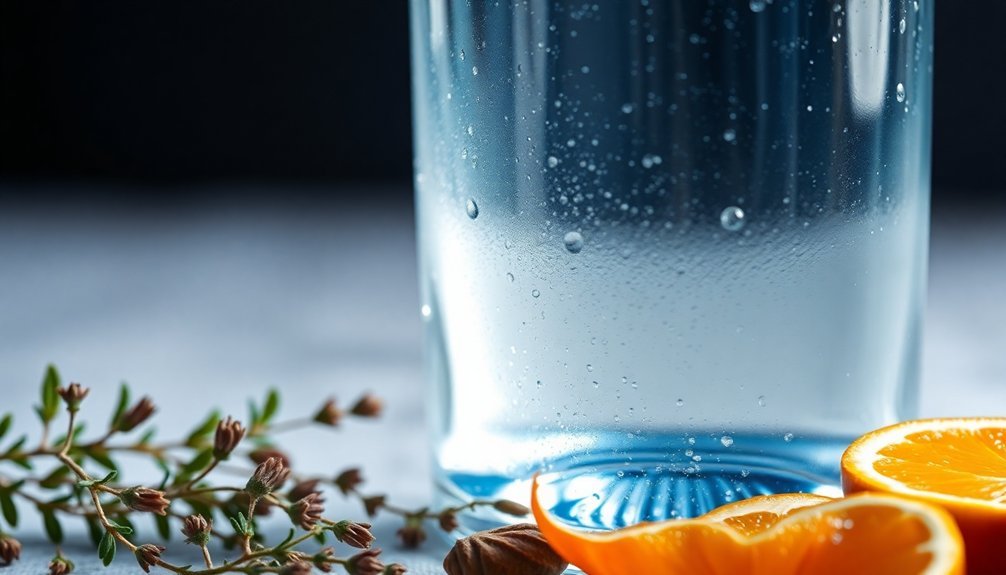
While many people know vodka primarily as a spirit, its unique chemical properties make it an effective natural solvent. You'll find that vodka's ethanol molecules can dissolve both polar and nonpolar substances, making it perfect for extracting essential oils and fragrances.
Its ability to mix with water creates a balanced solution that won't separate over time. The solution becomes three times as viscous when mixed at room temperature, enhancing its ability to hold fragrances.
When you use vodka as a perfume solvent, you're taking advantage of its hydrate-forming capabilities. The ethanol molecules form cage-like structures with water molecules, creating stable compounds that can effectively hold fragrance molecules.
Additionally, vodka's reduced surface tension helps disperse scents more effectively. The hygroscopic nature of ethanol means it'll readily absorb moisture from the air, helping to stabilize and preserve your fragrance while maintaining its chemical integrity.
Benefits of Choosing Vodka for DIY Perfumes
Although commercial perfumers typically opt for pure perfumer's alcohol, vodka offers several unique advantages for DIY fragrance creators.
You'll find it has a neutral scent profile that won't interfere with your fragrance composition, allowing your chosen scents to shine through. Its natural antibacterial and astringent properties not only help preserve your creation but can also benefit your skin when applied. When mixed with essential oils, it creates an effective natural bug repellent.
What makes vodka particularly appealing is its ability to create a uniform blend while supporting the gradual release of scents. As it evaporates, it helps unfold your fragrance's heart and base notes in a nuanced way.
While it's true that vodka's 40% alcohol content isn't ideal for all essential oils, it's still a safer, less toxic option compared to isopropyl alcohol, making it suitable for gentle skin applications.
Essential Equipment for Vodka-Based Extraction
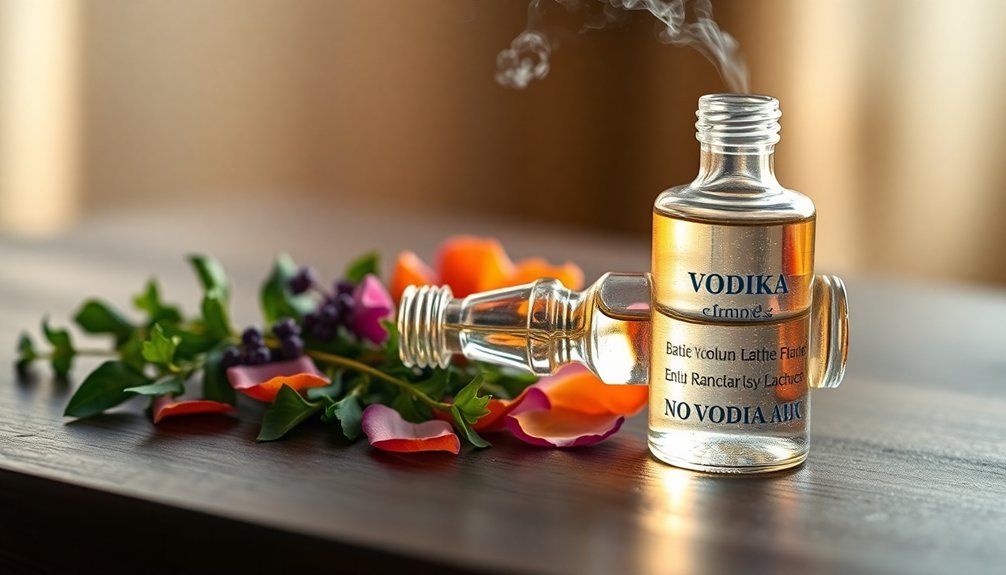
To start making vodka-based perfumes, you'll need basic laboratory-grade glass containers like beakers, funnels, and measuring flasks that prevent contamination of your fragrances.
You'll also want precise digital scales for accurate measurements of your ingredients, along with graduated cylinders for the liquid components. A professional oil-liquid separator is essential for concentrating your fragrance by removing any excess vodka after extraction.
For storing your finished perfume blends, it's crucial to have small glass bottles with secure closures that protect the fragrance from air exposure and environmental factors.
Basic Tools Needed
Successful vodka-based perfume extraction requires three fundamental categories of equipment: distillation tools, liquid handling supplies, and safety gear.
You'll need a stainless steel or glass distillation set with a condenser and plant material basket for the extraction process.
Essential liquid handling tools include measuring containers, pipettes, and funnels to manage your vodka solvent accurately. Don't forget stirring rods for thorough mixing.
For safety and precision, you'll want to equip yourself with a reliable thermometer, protective gear like goggles and gloves, and proper filtration systems.
Your collection containers should be glass, and you'll need filters to remove impurities. A cooling system helps maintain ideal temperatures, while a vacuum pump can reduce extraction temperatures to protect delicate fragrance compounds.
Storage Containers and Supplies
Proper storage containers and supplies serve as the backbone of vodka-based perfume extraction. You'll need dark glass bottles with tight-fitting lids to protect your fragrance from light degradation and prevent the escape of volatile compounds. Keep your containers meticulously clean and store them in a cool place to maintain fragrance integrity.
| Essential Item | Primary Use | Key Feature |
|---|---|---|
| Glass Bottles | Storage | Light protection |
| Carrier Oils | Dilution | Stability |
| Funnels | Transfer | Spill prevention |
When handling your supplies, make certain you're working in a well-ventilated area, as vodka-based extractions can release strong vapors. You'll also want to stock up on jojoba or fractionated coconut oil for dilution, and maintain a collection of various-sized containers to accommodate different batch volumes. Always label your containers clearly and check them regularly for seal integrity.
Step-by-Step Vodka Extraction Process
You'll need to carefully combine your chosen fragrant oils with vodka using gentle swirling motions, allowing the alcohol's natural properties to extract and dissolve the aromatic compounds.
When performing the extraction, work in a well-ventilated area and keep the mixture away from open flames since vodka's high alcohol content makes it flammable.
After the extraction period, strain the mixture through fine filters or coffee papers, then store your perfume base in dark glass bottles away from direct sunlight and heat.
Vodka-Oil Mixing Methods
Blending vodka with essential oils requires a methodical approach to achieve the perfect fragrance concentration.
You'll want to start with the standard ratio of 20% essential oils to 80% vodka, though you can adjust this based on your desired scent intensity. For a smaller batch, try mixing 30 ml of vodka with 90 drops of essential oils for a 15% concentration.
Begin your mixing process by adding base notes to a glass container, followed by middle and top notes.
Keep track of each drop you add to guarantee you can recreate your signature scent later. Once you've combined all ingredients, let your mixture mature for at least 24 hours.
For the best results, you can extend the maturation period to a month or two before transferring to a dark glass bottle.
Safety During Extraction
Now that you've mastered the mixing ratios, let's focus on the safety measures that protect you during the extraction process.
Always conduct a patch test before working with any new vodka-oil blend to check for potential skin reactions. You'll need to dilute high-proof vodka properly to prevent skin irritation.
Keep emergency equipment nearby, including a shower station that can flush affected areas for at least 15 minutes if spills occur. If you're working in a professional setting, guarantee you've got access to tank showers or indoor shower units.
While vodka's neutral odor makes it ideal for extraction, its high alcohol content demands careful handling. Mix your ingredients in a well-ventilated area and use appropriate dilution ratios with carrier oils to reduce sensitivity risks.
Filtration and Storage Tips
After completing the initial extraction, proper filtration becomes essential for achieving a refined and stable perfume base.
You'll want to start with activated charcoal filtration to remove any unwanted odors that might interfere with your perfume's intended fragrance. For best results, consider multiple filtrations through metal filters, which will give your solution a smoother, more refined texture.
Once you've filtered your vodka-based perfume, store it in a clean, sealed container away from direct sunlight. Since vodka doesn't require aging, you'll want to maintain its fresh, pure state.
Be certain you're using high-quality, treated water for any necessary dilutions to maintain the solution's clarity and stability. Before bottling your final product, run a quality check to verify there aren't any particles or cloudiness that could affect your perfume's performance.
Ideal Botanicals for Vodka Infusion
The art of selecting botanicals for vodka-based perfumes requires careful consideration of their aromatic profiles and infusion properties.
You'll want to start with citrus oils as your top notes, where lemon oil infuses quickly and orange oil adds an uplifting freshness.
For middle notes, try lavender or ylang ylang to create a balanced floral heart, while bay leaves contribute warmth.
Your base notes will anchor the fragrance, so consider using cedarwood or sandalwood oil for a rich, woody foundation.
Patchouli works particularly well in vodka, providing an earthy depth that lingers.
If you're looking to add complexity, spices like cardamom and cinnamon can enhance your blend, though you'll need to monitor their infusion time carefully to avoid overwhelming the other scents.
Proper Dilution Ratios and Measurements
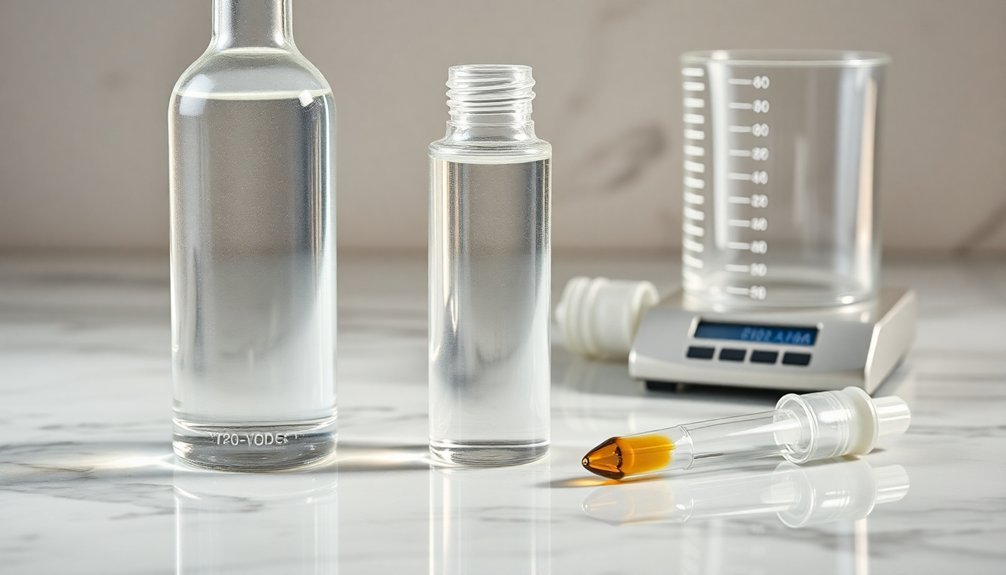
You'll need precise measurements and consistent ratios when mixing botanicals with vodka, starting with a basic 1:4 ratio of botanical material to vodka for initial testing.
Using a digital scale accurate to 0.01g helps guarantee repeatable results, while keeping detailed notes of your measurements allows you to adjust future batches.
Begin with small test batches of 10-15ml before scaling up your successful formulations, measuring both your botanical ingredients and vodka by weight rather than volume.
Mixing Ratios For Success
Creating successful perfumes hinges on three essential mixing ratios: eau de parfum (15-20% fragrance oil), eau de toilette (5-15% fragrance oil), and eau de cologne (2-5% fragrance oil).
You'll need to measure your fragrance oils by weight rather than volume for the most accurate results. Using a scale guarantees you'll achieve the perfect concentration every time.
When working with vodka as your solvent, remember to maintain consistency in your measurements and document your formulations carefully.
Start with the base notes, then add middle and top notes according to your chosen ratio.
- A sleek digital scale displaying precise measurements in grams
- Crystal-clear vodka being carefully pipetted into an amber bottle
- Fragrant oils forming mesmerizing swirls as they blend with the solvent
Always check the IFRA guidelines for maximum usage rates before finalizing your mixture.
Testing Small Batches First
Starting with small test batches allows perfumers to perfect their formulations without wasting precious materials. You'll want to measure ingredients by weight rather than volume to guarantee accuracy and repeatability in your creations. Professional perfumers typically dilute materials to workable concentrations before blending.
| Dilution % | Material (g) | Solvent (g) |
|---|---|---|
| 20% | 2.0 | 8.0 |
| 10% | 1.0 | 9.0 |
| 5% | 0.5 | 9.5 |
| 1% | 0.1 | 9.9 |
| 0.5% | 0.05 | 9.95 |
When calculating your dilutions, use weight-to-weight ratios for consistent results. While vodka might seem like a convenient option, it's not ideal for perfumery due to its impurities and distinct odor. Instead, opt for perfumer's alcohol or BBHCs with polarity modifiers to achieve better fragrance performance and longevity.
Measuring Tools And Methods
Precise measurements form the foundation of successful perfume creation, requiring both the right tools and proper methodologies. You'll need accurate digital scales, graduated pipettes, and volumetric measuring cups to guarantee proper dilution ratios when using vodka as your solvent.
For a 10% dilution, you'll combine 10% of your fragrance oils with 90% vodka, always double-checking your calculations before mixing.
- A pristine glass beaker catching the light as you carefully measure vodka to the exact milliliter mark
- A precise digital scale displaying numbers that flash and stabilize as you add drops of essential oil
- A row of clean, labeled glass vials awaiting their perfectly measured contents
Remember to tare your scale before each measurement and maintain consistency in your units throughout the process – this precision will make the difference between success and failure.
Storage and Aging Guidelines
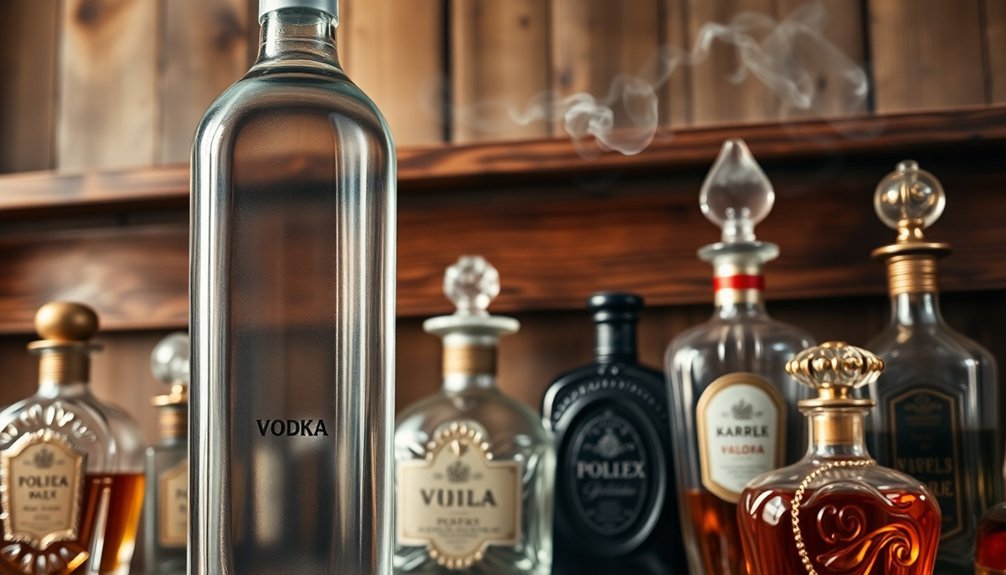
To maintain vodka's effectiveness as a perfume solvent, proper storage conditions are essential for preserving its quality and chemical stability.
You'll need to store your vodka in a cool, dark place away from direct sunlight and heat sources. A cupboard or drawer is ideal, as long as it's well-ventilated to prevent vapor buildup.
Keep your vodka in airtight containers and minimize air exposure by ensuring the lid is tightly sealed after each use.
For long-term storage, consider decanting into smaller containers to reduce oxidation risks. You can extend your vodka's shelf life up to two years by maintaining stable temperatures and low humidity levels.
If moisture's a concern, add silica gel packets to your storage area.
Watch for any changes in odor or appearance that might indicate degradation before using it in your perfume formulations.
Safety Precautions and Best Practices
Beyond proper storage methods, safe handling of vodka as a perfume solvent demands careful attention to prevent accidents and guarantee personal protection.
You'll need to work in a well-ventilated area, away from any heat sources or open flames. If spills occur, clean them immediately with dry cloths and dispose of them properly. Always wear protective gloves and eye protection when handling your vodka-based perfume solutions.
- Picture yourself working at a clean, clutter-free workspace with windows open to allow fresh air circulation.
- Imagine having a designated storage area with clearly labeled bottles, far from any electrical equipment or heat sources.
- Visualize keeping a spill kit nearby, complete with absorbent materials and protective gear.
Remember to test diluted solutions on a small patch of skin first, as some people may experience sensitivity even to diluted alcohol-based perfumes.
Common Mistakes to Avoid
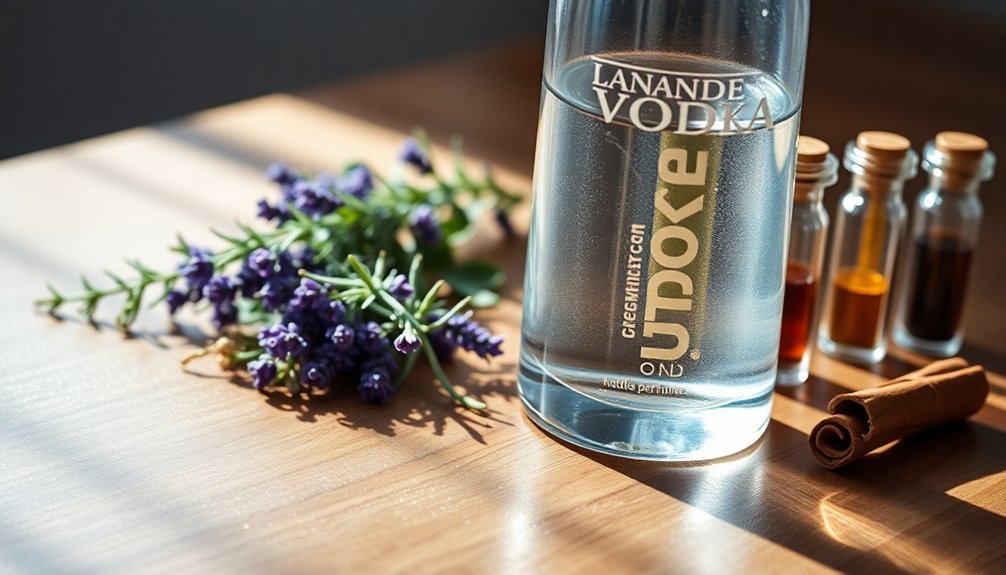
Understanding common mistakes can prevent costly setbacks when using vodka as a perfume solvent.
You'll want to avoid using standard vodka, which only contains 40% alcohol – far too low for proper perfumery. The high water content will cause your essential oils to separate rather than dissolve, resulting in an unappealing, cloudy mixture.
Don't substitute witch hazel or rubbing alcohol, as they'll create more problems than solutions.
Witch hazel contains even less alcohol than vodka, while isopropyl alcohol's harsh scent will overpower your fragrance and irritate your skin.
Never use methanol, as it's highly toxic and dangerous for skin contact.
To create quality perfumes, you'll need high-proof alcohol (95% or higher) that properly dissolves oils and maintains your intended scent profile.
Enhancing Fragrance Longevity
After mastering the proper alcohol concentration, you'll want to focus on making your fragrances last longer. Vodka's unique properties make it an excellent solvent for extending the life of your essential oil blends.
It acts as a natural preservative, preventing bacterial growth while maintaining the integrity of aromatic compounds. You'll find that vodka's neutral scent won't interfere with your carefully crafted fragrance combinations.
- Picture a drop of essential oil dancing through the vodka, creating a perfectly clear and stable mixture
- Imagine the delicate aromatic molecules being preserved like precious jewels in a protective vault
- Visualize the slow, controlled release of fragrance throughout the day, like a perfectly timed symphony
The vodka's ability to evenly disperse oils while protecting their volatile compounds guarantees your perfume remains vibrant and long-lasting.
Alternative Extraction Methods Compared
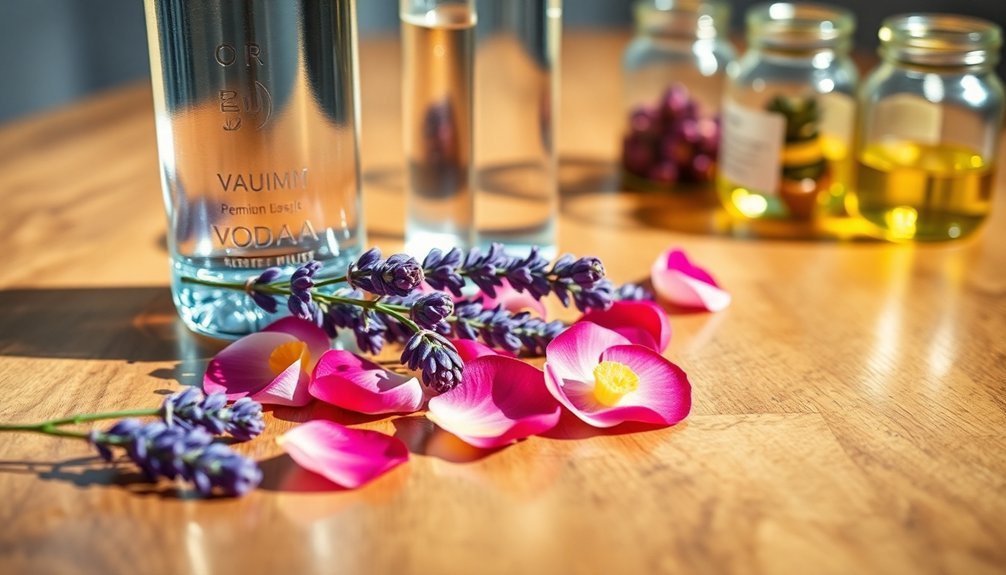
While vodka serves as an excellent solvent for DIY perfumes, professional fragrance extraction relies on several sophisticated methods, each with distinct advantages. You'll find that steam distillation offers a pure, solvent-free approach but can damage delicate compounds with heat. Solvent extraction captures complex fragrances effectively but risks leaving chemical residues. The traditional enfleurage method preserves the most delicate scents but requires intensive labor and time.
| Method | Best For | Watch Out For |
|---|---|---|
| Steam Distillation | Heat-resistant botanicals | Temperature damage |
| Solvent Extraction | Complex fragrances | Chemical residues |
| Supercritical CO2 | Precise extraction | High setup costs |
If you're choosing between professional methods, supercritical CO2 extraction offers the best balance of purity and efficiency, though it's the most expensive to implement.
Frequently Asked Questions
Can I Use Flavored Vodka to Create Unique Scent Combinations?
You shouldn't use flavored vodka for perfumes as it'll interfere with your essential oils. The added flavors can disrupt your fragrance's balance and may create unpredictable, possibly unpleasant scent combinations over time.
Will Vodka-Based Perfumes Stain Clothing or Jewelry?
Yes, your vodka-based perfumes will likely stain your clothes and damage jewelry. The water content causes fabric staining, while the alcohol-water mixture can tarnish metals and leave residues on your accessories.
How Does Altitude Affect Vodka Extraction of Botanical Fragrances?
You'll find altitude mainly affects your vodka's extraction through pressure changes. While it won't greatly impact the CO2 extraction process, you'll need to adjust distillation temperatures to maintain consistent botanical fragrance extraction.
Can I Combine Vodka-Based Perfumes With Commercial Fragrances?
You shouldn't combine vodka-based perfumes with commercial fragrances. The high water content and low alcohol percentage will cause separation, destabilize the fragrance compounds, and create an inconsistent mixture that won't blend properly.
Does the Brand or Price of Vodka Affect Extraction Quality?
You don't need expensive vodka for good extraction. The ethanol content (typically 40%) is what matters most, and most brands are similar. Just make certain you're using pure vodka without added flavors or additives.
In Summary
You'll find vodka is an accessible and effective solvent for creating natural perfumes at home. Its neutral scent, water-alcohol balance, and low cost make it ideal for botanical extraction. While other methods exist, vodka-based perfumes offer a safe, straightforward approach that you can master with practice. Remember to follow safety guidelines, select quality ingredients, and be patient as your fragrances develop their unique character.

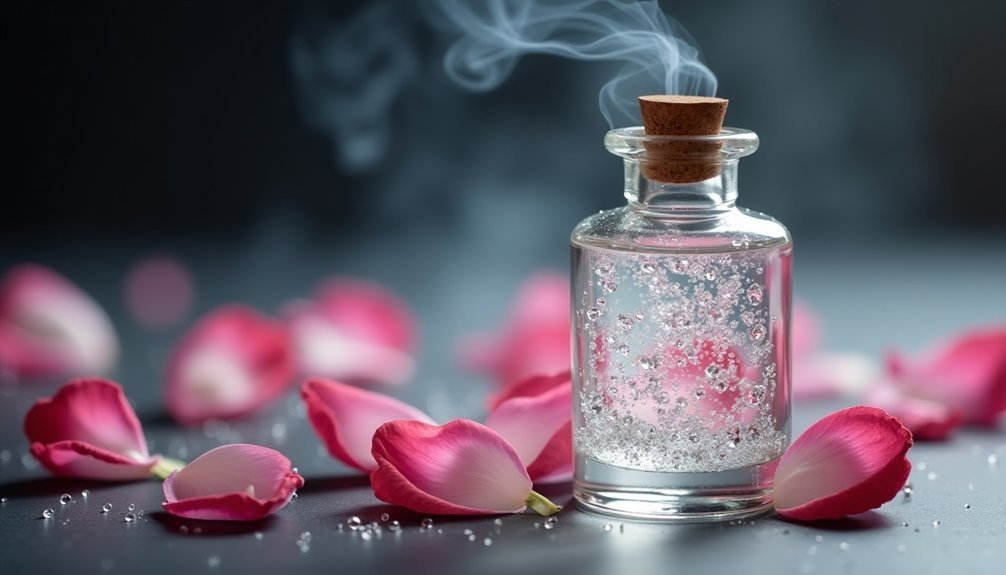



Leave a Reply